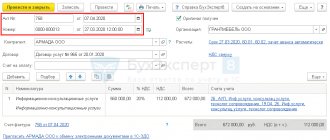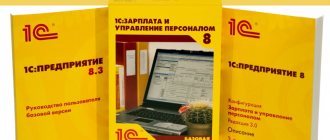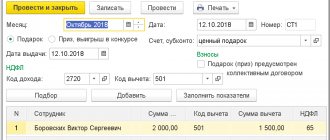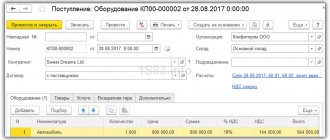How to reflect VAT restoration in 1C 8.3
In the 1C 8.3 Accounting database, VAT restoration is reflected in the VAT accounting registers. Influences the formation of the Sales Book and the Purchase Book and forms accounting entries: Dt 19 Kt 68.
The restored amount of input VAT previously accepted for deduction should be indicated in the Sales Book. To include the restored tax in the Sales Book, use invoices for which input VAT was accepted for deduction.
To reflect the VAT restoration operation in 1C 8.3, you should go to the Operations menu, then to Regular VAT operations:
Button Create – VAT Restoration:
Subsidy for upcoming purchase
The subsidy was received to finance upcoming expenses, that is, before the purchase of goods, works, and services.
The amount of the subsidy received does not need to be included in the VAT tax base. After all, it is not yet associated with payment for goods (work, services) sold by the taxpayer.
If among the conditions for granting a subsidy there is a clause that the costs of purchasing goods (work, services) are financed taking into account the tax presented by suppliers, the amount of VAT on goods (work, services) that will be paid through such a subsidy is not deductible are accepted.
If the subsidy is received to finance future expenses for the purchase of goods (work, services), including VAT, the subsidy amount is not included in the tax base and future input VAT on purchases made is not deducted.
Restoration of VAT previously accepted for deduction in 1C 8.3
Let's consider an example of VAT restoration in 1C 8.3 on goods that were used for non-productive needs of the enterprise.
Let's say an organization held a gala evening. For these purposes, utensils purchased earlier were used. When purchasing tableware with VAT, the goods were entered into the warehouse, paid, an invoice was received from the supplier and VAT was claimed for deduction in 2015. That is, earlier in 1C 8.3 a VAT posting was generated: Dt 68.02 Kt 19.3.
For the evening, the dishes were written off from the warehouse: Dt 91 Kt 10.3. This means that part of the VAT on previously capitalized dishes should be restored, that is, returned to the budget, since this product was not used for production purposes.
First of all, in 1C 8.3 we make an entry in the VAT recovery operation. Using the Add button, select the supplier of this product:
and the invoice on which this item was received:
In 1C 8.3, a complete list of all invoices received from a given supplier opens. Having selected the desired invoice, add it to the list.
Next, fill in all the details. We set the amount for which VAT was restored manually based on the Write-off Certificate, that is, for what amount the dishes were released from the warehouse. For example, this is 500,000 rubles. Accordingly, VAT for restoration will be 90,000 rubles = 500,000 * 18%:
If there is no invoice, let’s say the storage period has expired, then entries in the Sales Book can be made using an accounting certificate with the calculation of the amount of VAT to be restored.
In 1C 8.3, VAT can be restored for all documents and transactions listed in the list that opens when filling out the document. All operations are written similarly:
The result is a wiring:
It is also necessary to restore VAT on previously acquired or constructed real estate that is used for non-production purposes. The mechanism for filling out the document is similar to the example above.
Procedure for VAT recovery in case of receiving a subsidy
If the enterprise did not receive the subsidy in full, then how to calculate the share of VAT subject to restoration?
05/22/2019Russian tax portal
Answer prepared by:
Expert of the Legal Consulting Service GARANT
Volkova Olga
Response quality control:
Reviewer of the Legal Consulting Service GARANT
Candidate of Economic Sciences Ignatiev Dmitry
The company is a fabric manufacturer. The enterprise does not belong to those specified in Art. 4 of the Federal Law of August 3, 2018 N 303-FZ.
Is it necessary to restore previously deductible VAT if the taxpayer receives subsidies from the budgets of the budget system of the Russian Federation to reimburse costs associated with payment for purchased goods (works, services):
– if the subsidy was received in 2021 excluding VAT;
– if the subsidy was received in 2021;
– if the subsidy was approved in 2021 and received in 2018?
If the enterprise did not receive the subsidy in full, how to calculate the share of VAT subject to restoration
(example for calculation: expenses incurred by an enterprise in 2018 that are subject to subsidies are 118,000 rubles, including VAT 18,000.00 rubles; the subsidy received in 2021 is 100,000 rubles)?
Which share calculation is considered correct:
a) the share for calculating VAT is 0.847, that is, (RUB 100,000.00 – RUB 15,254.24) / (RUB 118,000.00 – RUB 18,000.00), that is, the VAT subject to recovery is equal to RUB 15,246 (RUB 18,000 x 0.847);
b) share for calculating VAT 1, that is, 100,000.00 rubles. / (RUB 118,000.00 – RUB 18,000.00), that is, the VAT subject to recovery is 18,000.00 (RUB 18,000.00 x 1)?
Having considered the issue, we came to the following conclusion:
When an enterprise received subsidies in 2021 (including those approved in 2021) for reimbursement of costs associated with payment for purchased goods (works, services), both including VAT and excluding VAT, it had to restore previously lawfully accepted to deduct tax amounts in the prescribed manner. So, based on the conditions of the example you provided, in case of partial reimbursement of costs, in our opinion, the amount of VAT in the amount of 18,000 rubles was subject to recovery.
When an enterprise receives subsidies in 2021 to reimburse previously incurred costs for the purchase of goods (works, services) excluding VAT, it should not restore the tax amounts previously lawfully accepted for deduction. This needs to be done only if the documents on the provision of subsidies provide for reimbursement of costs for the purchase of goods (works, services), including VAT.
Rationale for the conclusion:
The rules establishing the obligation to restore VAT (hereinafter also referred to as tax) when receiving subsidies to reimburse the costs of purchasing goods (works, services), as well as defining the appropriate procedure, are enshrined in paragraphs. 6 clause 3 art. 170 of the Tax Code of the Russian Federation, which has undergone changes in recent years.
So, the wording of paragraphs. 6 clause 3 art. 170 of the Tax Code of the Russian Federation, in force from 01.01.2018 to 31.12.2018, obligated taxpayers to restore the amounts of VAT previously legally accepted for deduction on goods (works, services), when receiving, in accordance with the legislation of the Russian Federation, subsidies from the budgets of the budget system of the Russian Federation for reimbursement of costs, related to payment for the specified goods (works, services), regardless of the fact that the amount of tax is included in the subsidies provided (with some exceptions that are not relevant for the case under consideration) (for more information, see, for example, letter of the Ministry of Finance of Russia dated September 13, 2018 N 03-07-11 /65645). The amounts of tax accepted for deduction were subject to restoration in the amount previously accepted for deduction, with the exception of cases of partial reimbursement of expenses, in which the amounts of tax accepted for deduction were subject to restoration in the appropriate share (hereinafter referred to as the Share), determined based on the cost of goods (work, services) without accounting for taxes acquired through subsidies for cost recovery in the total cost of purchased goods (works, services) excluding tax. No exceptions to this rule have been established for subsidies approved in 2021.
Thus, we believe that when an enterprise receives subsidies in 2018 (including those approved in 2021) for reimbursement of costs associated with payment for purchased goods (works, services), both including VAT and excluding VAT, it should was to restore previously lawfully accepted tax amounts for deduction in the manner prescribed by paragraphs. 6 clause 3 art. 170 Tax Code of the Russian Federation. So, based on the conditions of the example you provided, in case of partial reimbursement of costs, in our opinion, the amount of VAT in the amount of 18,000 rubles was subject to recovery, that is, calculated on the basis of Share 1 (100,000 rubles / (118,000 rubles - 18,000 rubles) ). We have not found any official explanations regarding the procedure for determining the Share in situations similar to the one under consideration.
From 01/01/2019 pp. 6 clause 3 art. 170 of the Tax Code of the Russian Federation establishes that the restoration of VAT when a taxpayer receives, in accordance with the legislation of the Russian Federation, from the budgets of the budget system of the Russian Federation subsidies to reimburse previously incurred costs for the purchase of goods (works, services), should be carried out only if the subsidies cover the taxpayer’s costs of paying “ input" VAT. In the part not covered by subsidies, the tax does not need to be restored (see, for example, letters from the Ministry of Finance of Russia dated December 12, 2018 N 03-07-11/90139, dated December 4, 2018 N 03-07-11/87519). The procedure for calculating the amount of VAT subject to restoration in the event of partial reimbursement of costs has also changed: if the taxpayer receives subsidies to reimburse part of the previously incurred costs for the purchase of goods (work, services), the amount of tax accepted for deduction on the specified goods (work, services) is subject to restoration, in the corresponding share, defined as the ratio of the amount of subsidies, at the expense of which the costs of purchasing goods (work, services) were reimbursed, to the total cost of these goods (work, services), taking into account the tax amounts presented to the taxpayer. Updated provisions of paragraphs. 6 clause 3 art. 170 of the Tax Code of the Russian Federation are applied to goods (works, services), the purchase costs of which are reimbursed through subsidies received from the budgets of the budget system of the Russian Federation starting from 01/01/2019 (Part 8 of Article 9 of the Federal Law of November 27, 2018 N 424-FZ ).
Consequently, when an enterprise receives subsidies in 2021 to reimburse previously incurred costs for the purchase of goods (works, services) excluding VAT, it should not restore the tax amounts previously lawfully accepted for deduction. This needs to be done only if the documents on the provision of subsidies provide for reimbursement of costs for the purchase of goods (works, services), including VAT.
Post:
Comments
Recovering VAT from advances issued
How to reflect the recovery of VAT when offsetting advances issued to a supplier in 1C 8.2 is discussed using an example in the following article.
VAT is restored on advances for which VAT was previously claimed for deduction.
Let’s say that when paying advance payments, the enterprise applied a VAT deduction, and the supplier paid or declared the amount of VAT on the advance received.
To receive a deduction, the basis is the invoice issued for the advance payment. The document is issued for the amount of payment. Upon shipment, amounts are restored from both the buyer and the supplier.
If the taxpayer did not declare the amount of VAT to be deducted, then there is no need to restore the tax.
In the period when the goods actually arrive and are entered into the warehouse, the tax should be restored in the amount of the advance payment. After which you can make a deduction based on the supply invoice using the corresponding invoice.
Recovering VAT from advances received
When receiving an advance from the buyer, the company generates an invoice for the advance in two copies. The first is entered into the Sales Book, and the second is given to the buyer.
The advance invoice after shipment is entered into the Purchase Ledger, and the new document should be reflected in the Sales Ledger as a sale. In fact, the amount is restored during the shipment period.
The amount of the advance payment received may not coincide with the material assets actually shipped. The taxpayer returns the difference or issues a new invoice for the advance payment for the amount of the excess.
How to find and correct VAT errors in 1C 8.3, mechanisms for checking VAT calculations, how to use the 1C service Reconciliation of VAT accounting data is discussed in our video:
Give your rating to this article: (
2 ratings, average: 3.00 out of 5)
Registered users have access to more than 300 video lessons on working in 1C: Accounting 8, 1C: ZUP
Registered users have access to more than 300 video lessons on working in 1C: Accounting 8, 1C: ZUP
I am already registered
After registering, you will receive a link to the specified address to watch more than 300 video lessons on working in 1C: Accounting 8, 1C: ZUP 8 (free)
By submitting this form, you agree to the Privacy Policy and consent to the processing of personal data
Login to your account
Forgot your password?









